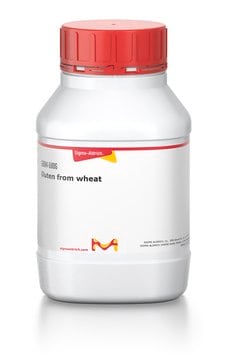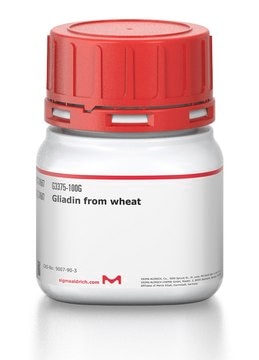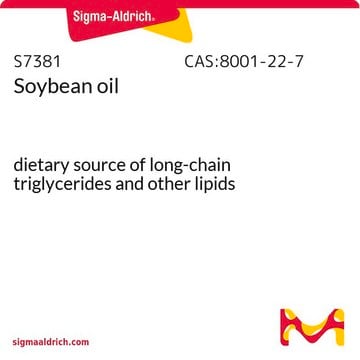S9633
Soybean flour
Type I
Synonym(s):
Soy flour, Soybean meal, Soybean protein powder
Sign Into View Organizational & Contract Pricing
All Photos(1)
About This Item
Recommended Products
biological source
Glycine max (soybean)
type
Type I
form
powder
composition
Protein, ~52% (85+% dispersible and 1% fat.)
application(s)
microbiology
Looking for similar products? Visit Product Comparison Guide
General description
Soybean flour is produced from the leguminous plant, soybean. It is a source of nine essential amino acids and has lesser carbohydrates and fat. Soybean flour is an excellent protein source. It is highly bioavailable and its isoflavone content prevents cardiovascular problems.
Application
A defatted, slowly available protein nutrient.
Soybean flour has been used:
- for optimizing Triton X-114 (TX-114) based lipopolysaccharide (LPS) extraction
- as a protein supplement in the in vitro fermentation of rumen fluid
- as a protein supplement in batch culture of bovine digesta to assess its degradation
Biochem/physiol Actions
Some studies have shown that soybean flour can be carcinogenic and induce pancreatic cancer in rats.
Preparation Note
Not roasted
Storage Class Code
11 - Combustible Solids
WGK
WGK 3
Flash Point(F)
Not applicable
Flash Point(C)
Not applicable
Personal Protective Equipment
dust mask type N95 (US), Eyeshields, Gloves
Certificates of Analysis (COA)
Search for Certificates of Analysis (COA) by entering the products Lot/Batch Number. Lot and Batch Numbers can be found on a product’s label following the words ‘Lot’ or ‘Batch’.
Already Own This Product?
Find documentation for the products that you have recently purchased in the Document Library.
Customers Also Viewed
Optimized Triton X-114 assisted lipopolysaccharide (LPS) removal method reveals the immunomodulatory effect of food proteins
Teodorowicz M, et al.
PLoS ONE, 12(3), e0173778-e0173778 (2017)
The fermentation of soybean meal by rumen microbes in vitro reveals different kinetic features for the inactivation and the degradation of trypsin inhibitor protein
Hoffmann EM, et al.
Anim. Feed Sci. Technol., 106(1-4), 189-197 (2003)
Functional and edible uses of soy protein products
Singh P, et al.
Comprehensive Reviews in Food Science and Food Safety, 7(1), 14-28 (2008)
Sheetal Shah et al.
Pest management science, 68(1), 38-48 (2011-06-18)
Insecticide discovery screens carried out on whole organisms screen for potency resulting from chemical activity at the target site. However, many potentially insecticidal compounds are naturally detoxified in vivo and do not make it to the target site. It is
Results of a screening programme to identify plants or plant extracts that inhibit ruminal protein degradation
Selje N, et al.
The British Journal of Nutrition, 98(1), 45-53 (2007)
Our team of scientists has experience in all areas of research including Life Science, Material Science, Chemical Synthesis, Chromatography, Analytical and many others.
Contact Technical Service








